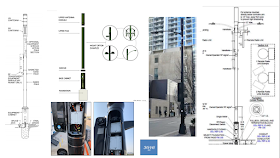There was a good report in FierceWireless about Verizon installing 5G in Denver using special ‘smart poles’. We have covered this topic of smart lampposts and poles extensively for many different countries including India, UK, Portugal, China and even Japan.
The article states:
The Boulder, Colorado-based company Comptek Technologies has designed stand-alone poles to house wireless small cell equipment that is completely hidden within the poles. The City of Denver has approved the design of these Comptek City Poles, and Verizon is now deploying them in Denver for 4G and 5G small cell equipment.
In addition to Verizon, Comptek is also working in different parts of the country with all the other major wireless carriers either directly or through their deployment partners. For instance, Comptek is working closely with its customer Xcel Energy, which has an eight-state footprint. Xcel is helping carriers to deploy their small cells on the utility’s existing vertical infrastructure. And in some cases, Xcel is taking down existing light poles and replacing them with Comptek poles that combine small cell equipment along with a streetlight.
The company has a national agreement with Verizon. Besides Denver, Comptek is working with Verizon in other cities including Columbus, Cleveland and Cincinnati, Ohio; Anaheim, San Diego and Los Angeles, California; as well as Salt Lake City. In the Denver/Front Range area, the company has about 350 poles under contract. And across the U.S. it’s got contracts to erect about 1,000 poles by the end of 2019.
CityPoles' website here isn't updated with the latest info but the earlier press release stated 300 small cells in Denver.
A nice looking small cell pole (https://t.co/R0mNf8fxae) – with RRUs & equipment inside the pole. Curious what happens in the future if there is a need to expand or add equipment. Is there enough space for expansion or would another pole likely be needed?#celltower #telecom pic.twitter.com/N28PVYmAdF— Ken Schmidt (@steelintheair) August 31, 2019
Continuing from the article:
The poles are designed in modular sections. There’s a foundation, base cabinet, shroud, upper pole and top antenna section. They’re custom-designed to incorporate various wireless equipment configurations, cabling, power supplies and antennas. In addition to the physical pole itself, Comptek also provides electronics and environmental controls. The poles can support single or multiple carriers.
Jim Lockwood, CEO of Comptek said that for 5G, Ericsson’s mmWave equipment is mounted in a tri-sector format, meaning that the radios and antennas are integrated with each other and they’re mounted at the top of the pole in three panels that face in different directions. Representatives from Ericsson and Verizon could not verify the "tri-sector format" or provide any additional information about it.
- Verizon Small Cell Presentation to City of Alexandria, Virginia - April 2019
- Small Cell Infrastructure in Denver - Denver Public Works
- XcelEnergy: Dual Use Streetlight/ Communication Poles
- Fierce Wireless: Verizon hits 10 5G cities with Phoenix launch
Related Posts:
- What is meant by Infrastructure in a Telecoms Network?
- Telecoms Infrastructure Blog: Some pictures of Small Cells from California (USA)
- Telecoms Infrastructure Blog: Verizon's got Balls and Small Cells
- Telecoms Infrastructure Blog: Verizon's Small Cells and the roadmap to 5G
- Telecoms Infrastructure Blog: NTT Docomo's Underground LTE Small Cells with possibility to deploy 5G in future
- Vodafone UK improving coverage with Phone Boxes, Mini-masts & Manhole Covers
- Three UK: Mobile Network Cell Tower Site Construction
- Mobile Network Infrastructure Sharing in Japan over Electric Power Infrastructure

I've been doing this recently. From what I have seen, the business case is not working out for cities. however, utilities seem to like the fact they can upgrade their poles and offer services. They see a viable payback for something they would do anyway.
ReplyDeleteCarriers are aggressively looking at expanding 4G and 5G, but they all have their own strategies. While we all love tis model, the FCC took out any income that could have been made. So, that priority is going down. Why do it if you can't make any money at it. The carriers will have to do more.
With that said, everyone wants 5G and when a carrier finds a section of town they want to cover, they can move ahead.
Many pole owners are starting to offload their poles, so the FCC's ruling may not apply to them.
Solutions for Wireless Tech Services, 5G, LTE, Analysis, Planning, Predesign, & Consulting Services
As for the IOT services, public safety and Homeland Security are seeing many opportunities to add IOT equipment to serve their needs. I am not talking cameras, there are other services that they want to install at these poles.
Everyone seems to think Wi-Fi is a great addition, and it is, however, who is paying for it and maintaining it? That is the question. Turns out cities and municipalities don't want to bother. Most cable companies would rather strand mount. But, it may gain momentum in the near future.